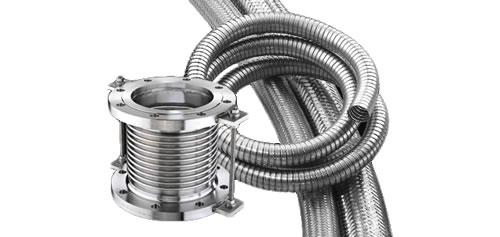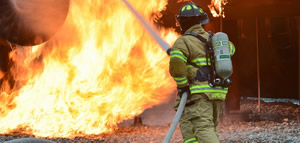Care, Maintenance & Storage
(Reprinted from RMA Hose Handbook IP-2 Sixth Edition 1996)
Hose has a limited life and the user must be alert to signs of impending failure, particularly when the conditions of service include high working pressures and/or the conveyance or containment of hazardous materials.
The periodic inspection and testing procedures described here provide a schedule of specific measures which constitute a minimum level of user action to detect signs indicating hose deterioration or loss of performance before conditions leading to malfunction or failure are reached.
SAFETY WARNING: Failure to properly follow the manufacturer's recommended procedures for the care, maintenance and storage of a particular hose might result in its failure to perform in the manner intended and might result in possible damage to property and serious bodily injury.
General instructions are also described for the proper storage of hose to minimize deterioration from exposure to elements or environments which are known to be deleterious to rubber products. Proper storage conditions can enhance and extend substantially the ultimate life of hose products.
General Care and Maintenance of Hose
Hose should not be subjected to any form of abuse in service. It should be handled with reasonable care. Hose should not be dragged over sharp or abrasive surfaces unless specifically designed for such service.
Care should be taken to protect hose from severe end loads for which the hose or hose assembly were not designed. Hose should be used at or below its rated working pressure; any changes in pressure should be made gradually so as to not subject the hose to excessive surge pressures.
Hose should not be kinked or be run over by equipment. In handling large size hose, dollies should be used whenever possible; slings or handling rigs, properly placed, should be used to support heavy hose used in oil suction and discharge service.
General Test and Inspection Procedures for Hose
An inspection and hydrostatic test should be made at periodic intervals to determine if a hose is suitable for continued service. A visual inspection of the hose should be made for loose covers, kinks, soft spots which might indicate broken or displaced reinforcement.
The couplings or fittings should be closely examined and, if there is any sign of movement of the hose from the couplings, the hose should be removed from service. The periodic inspection should include a hydrostatic test for one minute at 150% of the recommended working pressure of the hose. An exception to this would be the woven jacketed fire hose.*
During the hydrostatic test, the hose should be straight, not coiled or in a kinked position. Water is the usual test medium and, following the test, the hose may be flushed with alcohol to remove traces of moisture .A regular schedule for testing should be followed and inspection records maintained.
*Woven jacket fire hose should be tested in accordance with the service test provisions contained in the current edition of National Fire Protection Association Bulletin No. 1962 - Standard for the Care, Use and Service Testing of Fire Hose.
SAFETY WARNING:
Before conducting any pressure tests on hose, provisions must be made to ensure the safety of the personnel performing the tests and to prevent any possible damage to property. Only trained personnel using proper tools and procedures should conduct any pressure tests.
1. Air or any other compressible gas must never be used as the test media because of the explosive action of the hose should a failure occur. Such a failure might result in possible damage to property and serious bodily injury.
2. Air should be removed from the hose by bleeding it through an outlet valve while the
hose is being filled with the test medium.
3. Hose to be pressure tested must be restrained by placing steel rods or straps close to each end and at approximate 10 foot (3m) intervals along its length to keep the hose from "whipping" if failure occurs; the steel rods or straps are to be anchored firmly to the test structure but in such a manner that they do not contact the hose which must be free to move.
4. The outlet end of hose is to be bulwarked so that a blown-out fitting will be stopped.
5. Provisions must be made to protect testing personnel from the forces of the pressure media if a failure occurs.
6. Testing personnel must never stand in front of or in back of the ends of a hose being pressure tested.
7. When liquids such as gasoline, oil, solvent, or other hazardous fluids are used as the test fluid, precautions must be taken to protect against fire or other damage should a hose fail and the test liquid be sprayed over the surrounding area.
The Rubber Manufacturers Association has published separately a series of Hose Technical Information bulletins describing Maintenance, Testing and Inspection recommendations.
Reference should be made to the current RMA Catalog of Publications, to determine the availability of the latest edition. Bulletins published as of January 1996 include the following:
Publication No.
IP 11-1-Steam Hose
IP 11-2-Anhydrous Ammonia Hose
IP 11-4-0il Suction and Discharge Hose IP 11-5-Welding Hose
IP 11-7-Chemical Hose
IP 11-8-Fuel Dispensing Hose
Storage
Rubber hose products in storage can be affected adversely by temperature ,humidity, ozone, sunlight, oils, solvents, corrosive liquids and fumes, insects, rodents and radioactive materials.
The appropriate method for storing hose depends to a great extent on its size (diameter and length), the quantity to be stored, and the way in which it is packaged. Hose should not be piled or stacked to such an extent that the weight of the stack creates distortions on the lengths stored at the bottom.
Since hose products vary considerably in size, weight, and length, it is not practical to establish definite recommendations on this point. Hose having a very light wall will not support as much load as could a hose having a heavier wall or hose having a wire reinforcement. Hose which is shipped in coils or bales should be stored so that the coils are in a horizontal plane.
Whenever feasible, rubber hose products should be stored in their original shipping containers, especially when such containers are wooden crates or cardboard cartons which provide some protection against the deteriorating effects of oils, solvents, and corrosive liquids; shipping containers also afford some protection against ozone and sunlight.
Certain rodents and insects will damage rubber hose products, and adequate protection from them should be provided.
Cotton jacketed hose should be protected against fungal growths if the hose is to be stored for prolonged periods in humidity conditions in excess of 70%.
The ideal temperature for the storage of rubber products ranges from 50°To 70° F (10°C to 21°C) with a maximum limit of 100°F (38°C).If stored below 32°F (0°C), some rubber products become stiff and would require warming before being placed in service. Rubber products should not be stored near sources of heat, such as radiators, base heaters, etc., nor should they be stored under conditions
To avoid the adverse effects of high ozone concentration, rubber hose
products should not be stored near electrical equipment that may generate
ozone or be stored for any lengthy period in geographical areas of known
high ozone concentration. Exposure to direct or reflected
sunlight, even through windows, should also be avoided. Uncovered hose should not be stored under fluorescent or mercury lamps which generate light waves harmful to rubber.
Storage areas should be relatively cool and dark, and free of dampness and mildew. Items should be stored on a first-in, first-out basis, since even under the best of conditions, an unusually long shelf life could deteriorate certain rubber products.















